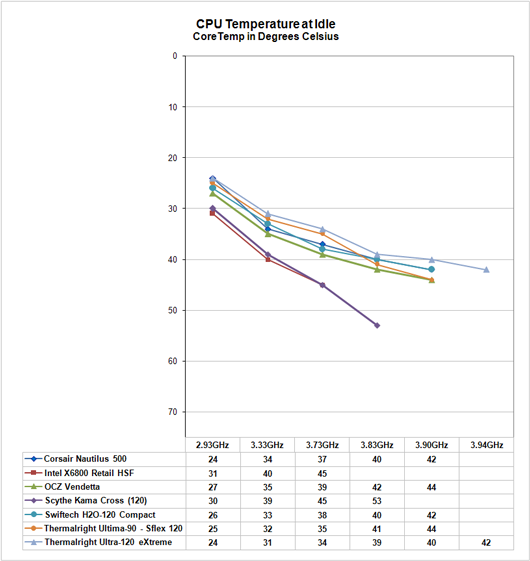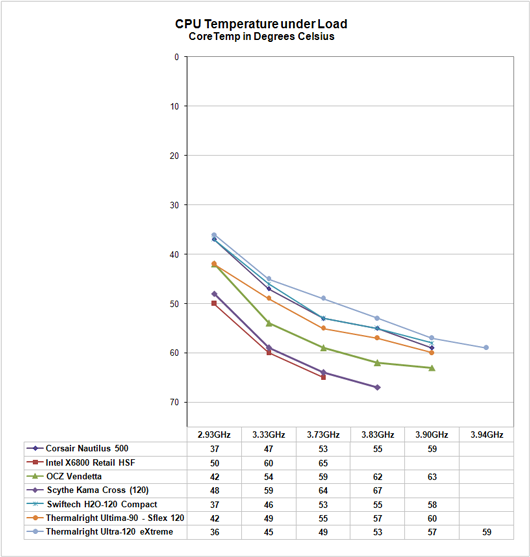New Mid-Priced Coolers from OCZ and Scythe: The Small and the X of It
by Wesley Fink on October 1, 2007 12:05 AM EST- Posted in
- Cases/Cooling/PSUs
Scaling of Cooling Performance
Decent performance at stock speeds is one thing, but we were interested in seeing how both these midrange air coolers scaled in cooling higher overclocks. With the change in test beds and temperature measurement utilities the method of displaying the test results has been changed. The scale is now reversed with zero on top and 75C on the bottom. This means the best performance is now displayed as the highest points in the graph (representing lowest temperature). The reference Intel retail cooler is now at the bottom of the results chart since it exhibits the poorest performance (highest temperatures) of our tested coolers.
The Scythe Kama Cross continues to be a disappointment, even though we tested with the larger and higher output Thermalright S-FLEX 120mm fan. Performance is only 1C better than the Intel retail at most overclocks, though the Kama Cross does reach a higher 3.83GHz compared to 3.73GHz with the retail cooler. Frankly, the smaller stock 100mm fan gave up little in performance to the well-regarded S-FLEX, indicating the fan is not the issue in this design - the heatsink itself appears the limitation.
With the stock 100mm fan performance was within 1C of the 120 fan results across the curve. It was a puzzle at first as to why Scythe equipped the Kama Cross with a 100mm fan when it was clearly designed to work with a 120mm fan. We can only conclude that after developing the cooler, Scythe realized the performance meant the Kama Cross would sell in the midrange and they did whatever was necessary to reduce the Kama Cross cost.
Looking closely at the curves of the top coolers tested, the OCZ Vendetta follows the pattern of the top coolers very closely, with slightly poorer performance across the speed curve. This is exactly what would be expected with a top midrange cooler. The Vendetta does not quite reach the top speed of the best and most expensive, but it comes close. It also scales well.
Cooling efficiency of the OCZ Vendetta and Scythe Kama Cross were then compared under load conditions to the retail HSF and other recently retested CPU coolers. Load testing can be very revealing of a cooler's efficiency. A basically flat line, particularly form 3.73GHz upward, indicates the cooler is still in its best cooling range. A line that is falling rapidly indicates a cooler nearing the end of its ability to cool efficiently. Lines which parallel the best coolers over a range of values are showing similar efficiency slopes.
The Kama Cross closely mirrored the Intel retail cooler. We would prefer a mirroring of the top Thermalright coolers indicating robust cooler scaling. By contrast the OCZ Vendetta, which is both smaller and handicapped by a smaller 92mm fan, mirrored the Ultima-90 and Ultra-120 eXtreme curves. This is very good performance.
As expected of a midrange cooler, the OCZ is warmer across the speed range at load than top coolers. While performance variations are greater, the curve still mirrors the top air coolers and reaches almost as high as the best air and water coolers.
Decent performance at stock speeds is one thing, but we were interested in seeing how both these midrange air coolers scaled in cooling higher overclocks. With the change in test beds and temperature measurement utilities the method of displaying the test results has been changed. The scale is now reversed with zero on top and 75C on the bottom. This means the best performance is now displayed as the highest points in the graph (representing lowest temperature). The reference Intel retail cooler is now at the bottom of the results chart since it exhibits the poorest performance (highest temperatures) of our tested coolers.
 |
| Click to enlarge |
The Scythe Kama Cross continues to be a disappointment, even though we tested with the larger and higher output Thermalright S-FLEX 120mm fan. Performance is only 1C better than the Intel retail at most overclocks, though the Kama Cross does reach a higher 3.83GHz compared to 3.73GHz with the retail cooler. Frankly, the smaller stock 100mm fan gave up little in performance to the well-regarded S-FLEX, indicating the fan is not the issue in this design - the heatsink itself appears the limitation.
With the stock 100mm fan performance was within 1C of the 120 fan results across the curve. It was a puzzle at first as to why Scythe equipped the Kama Cross with a 100mm fan when it was clearly designed to work with a 120mm fan. We can only conclude that after developing the cooler, Scythe realized the performance meant the Kama Cross would sell in the midrange and they did whatever was necessary to reduce the Kama Cross cost.
Looking closely at the curves of the top coolers tested, the OCZ Vendetta follows the pattern of the top coolers very closely, with slightly poorer performance across the speed curve. This is exactly what would be expected with a top midrange cooler. The Vendetta does not quite reach the top speed of the best and most expensive, but it comes close. It also scales well.
Cooling efficiency of the OCZ Vendetta and Scythe Kama Cross were then compared under load conditions to the retail HSF and other recently retested CPU coolers. Load testing can be very revealing of a cooler's efficiency. A basically flat line, particularly form 3.73GHz upward, indicates the cooler is still in its best cooling range. A line that is falling rapidly indicates a cooler nearing the end of its ability to cool efficiently. Lines which parallel the best coolers over a range of values are showing similar efficiency slopes.
 |
| Click to enlarge |
The Kama Cross closely mirrored the Intel retail cooler. We would prefer a mirroring of the top Thermalright coolers indicating robust cooler scaling. By contrast the OCZ Vendetta, which is both smaller and handicapped by a smaller 92mm fan, mirrored the Ultima-90 and Ultra-120 eXtreme curves. This is very good performance.
As expected of a midrange cooler, the OCZ is warmer across the speed range at load than top coolers. While performance variations are greater, the curve still mirrors the top air coolers and reaches almost as high as the best air and water coolers.










22 Comments
View All Comments
Wesley Fink - Monday, October 1, 2007 - link
There is only one game available that may possibly perform better with a quad CPU. Our original thinking was that we would wait to move to quad testing until games are launched that give us a reason to buy a quad-core - somewhere in the future.However, the point is well-taken that quads do generate more heat than dual-core processors, so we will be doing a comparison in the next few weeks on a range of coolers tested on a quad-core CPU.
Acanthus - Monday, October 1, 2007 - link
That is fantastic, not all of us buy quads for gaming :DI have one for encoding.
strikeback03 - Tuesday, October 2, 2007 - link
same here, though it would be nice if Premiere would make use of more than one core.Spacecomber - Monday, October 1, 2007 - link
The graphs and the discussion of them seemed out of synch, especially on page 5. It's as if the chart being discussed didn't get included or the discussion is meant for another section.Anyway, I got confused at that point, just looked at the graphs, and drew my own conclusions from there on. ;-)
Wesley Fink - Monday, October 1, 2007 - link
The Intel Retail results on p.5 had not been updated for CoreTemp results. That has now been updated. Hopefully the commentary now matches the graphs.Spacecomber - Monday, October 1, 2007 - link
Yup, the previous bar for the intel heatsink said something like 41 deg, which left me scratching my head.The discussion of how the cooling scaled with higher clock speeds also seemed out of place on that page, since there is no graphical representation of that until you get to page 7. Perhaps you were just making those comments paranthetically on page 5, but I wasn't clear why it was being discussed where all the results being graphically presented were for default clock speeds.
FrankThoughts - Monday, October 1, 2007 - link
...that took one look at the Scythe "I'm an X! Isn't that AWESOME!" design and immediately figured performance was going to suck? Repeat after me: gimmicky cooler designs do NOT work well! Just look at the first image of the cooler: all the closely packed fins, lots of gap between the fan and the fins, and you can already guess that most of the air so going to go around the fins rather than through them.Maybe a plastic shroud around the HSF would have helped, but even then a large amount of air would just go through the center gap. This is one of those designs that looks nifty but has some bassackwards thermodynamic "theory" at its core.
strikeback03 - Tuesday, October 2, 2007 - link
I'm just surprised they let something out that sucks this bad. If the performance were at least a little better than stock some might buy it for the looks, but this performance is just embarrassing to Scythe.puffpio - Monday, October 1, 2007 - link
I agreeYou can immediately look at it and see that the air the fan blows is going to go AROUND the heat sink...basic fluid dynamics..path of least resistance
But also w/ the OCZ cooler, they cut out some heat sink fins to make a curve shape...so you loose thermal capacity and gain aesthetics?
Someone needs to design an enthusiast heat sink and fan that consulted a thermal and aerodynamic engineer...perhaps tapping into the skill set of people who design car radiators..
KazenoKoe - Wednesday, October 3, 2007 - link
I would like to know how the Scythe cooler performs with 2 smaller fans, one for each heatsink, instead of one fan at an odd angle.